HSP “Solar Skin”, Quantum Age Airplane
"Extra" ECO-friendly Airplane


Published in April 2017
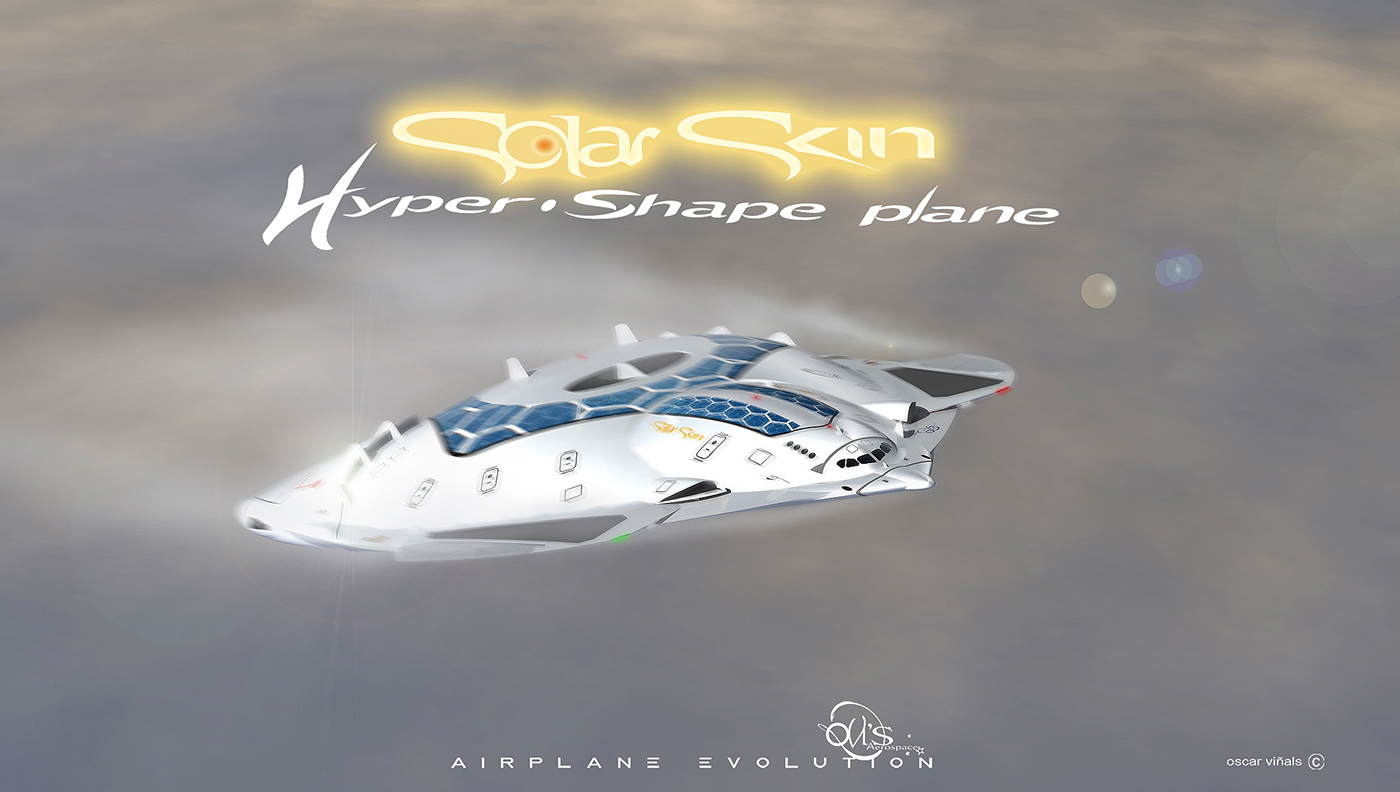
NEW PROJECT

A Concept Airplane ahead of its time

In the last two decades we have seen how the digital revolution came to flight control and airplane’s design. In 1995 the Boeing 777 has became in the first airplane entirely designed by computer, the next generation of airplanes could be the “Quantum Age”. With the help of advanced techniques of simulation (CFD- Computational Fluid Dynamics) and computer analysis (aerodynamics, aerostructures, propulsion systems, electronics, on board systems,…) together with the use of a new generation of materials like carbon fibre, new aluminum alloys, carbon nanotubes, nanowires and graphene, which are either in use today, under development or are considered for specific applications, the future airplane’s designs has substantially changed. Several design and configuration concepts are also being experimented and tested upon, and are currently being pursued by the airline industry. The new designs have changed radically its external appearance, which makes them extremely aerodynamic and holds great promise for dramatic reductions in fuel consumption, noise and emissions.









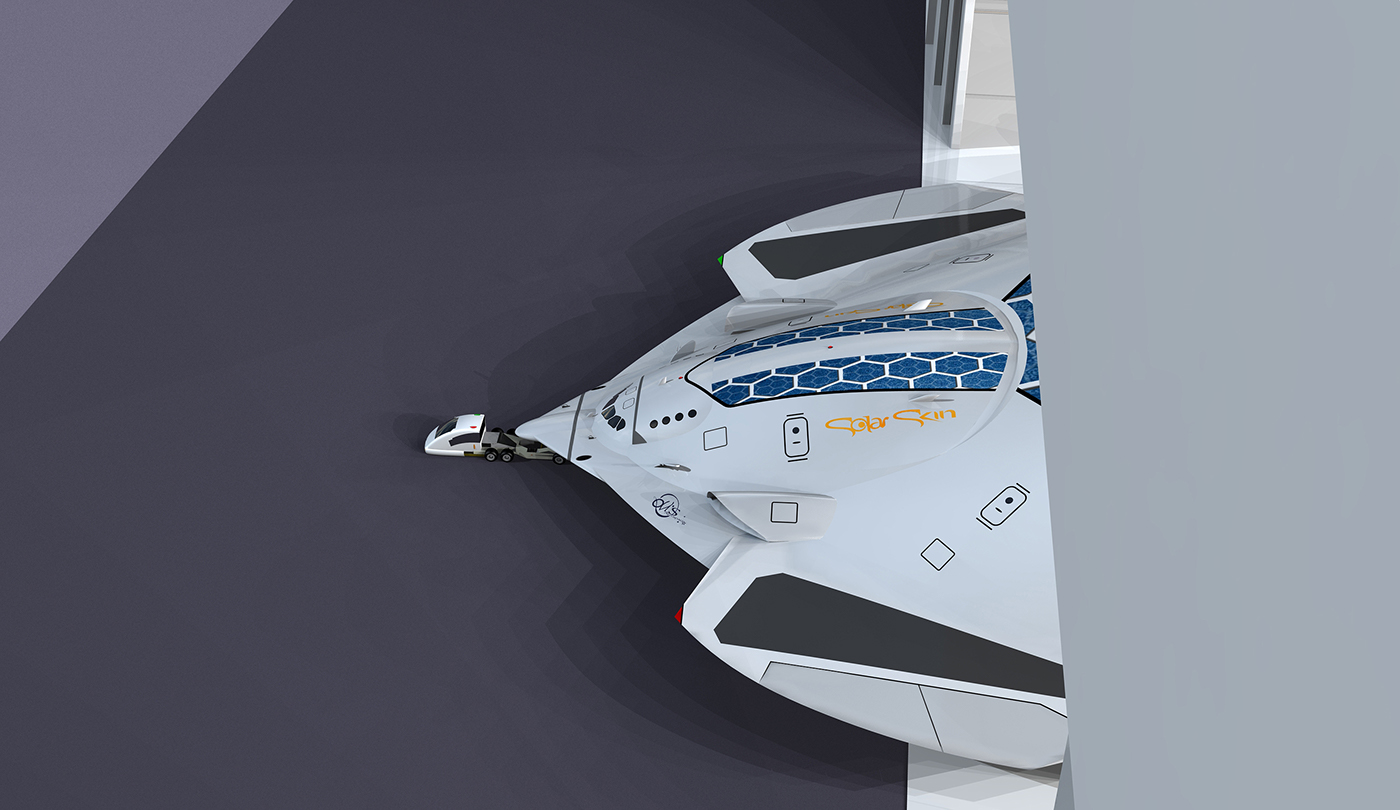
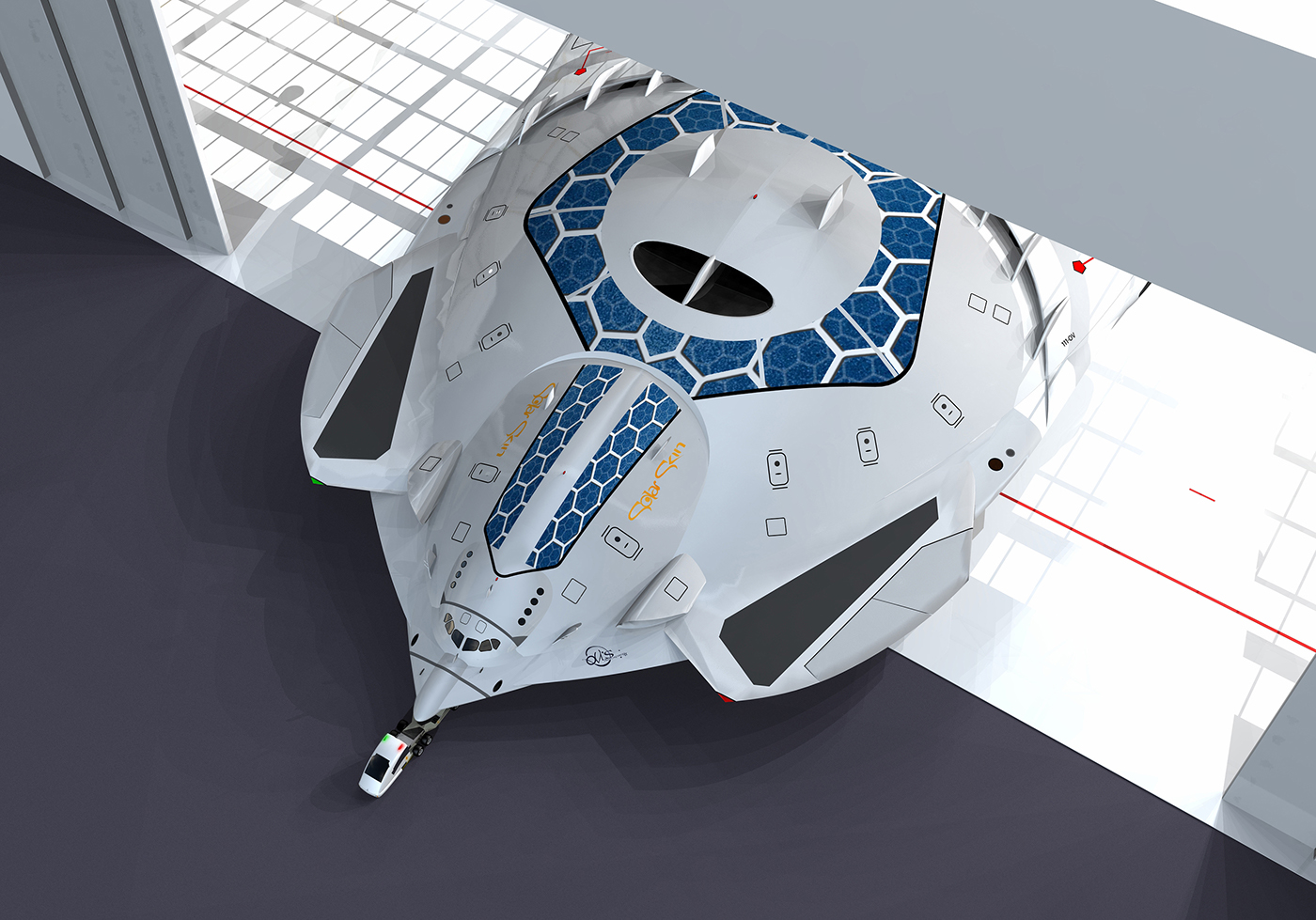
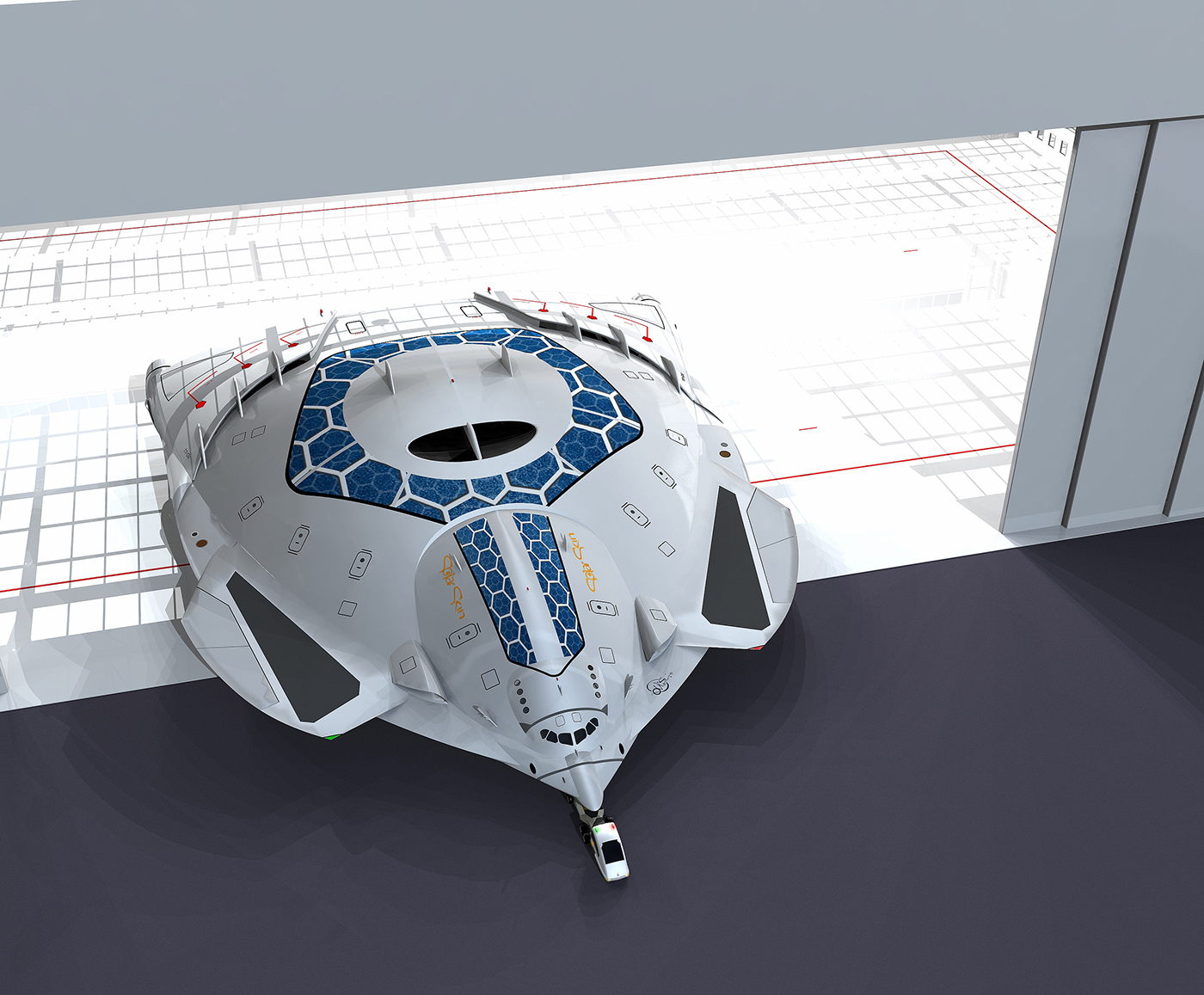
A New Class of Airplanes could be born with the
HSP "Solar Skin"... "The Hyper·shape Planes".
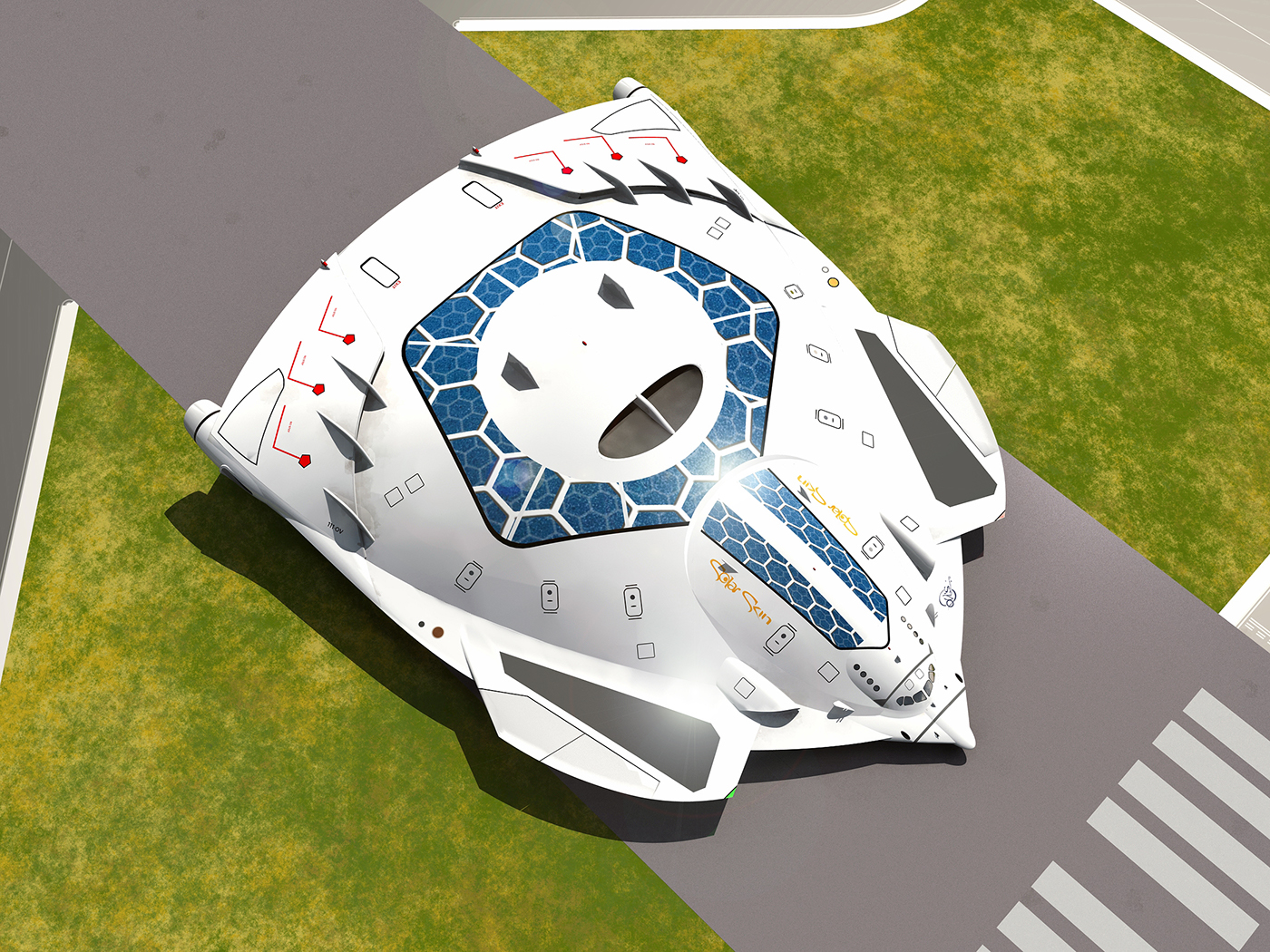
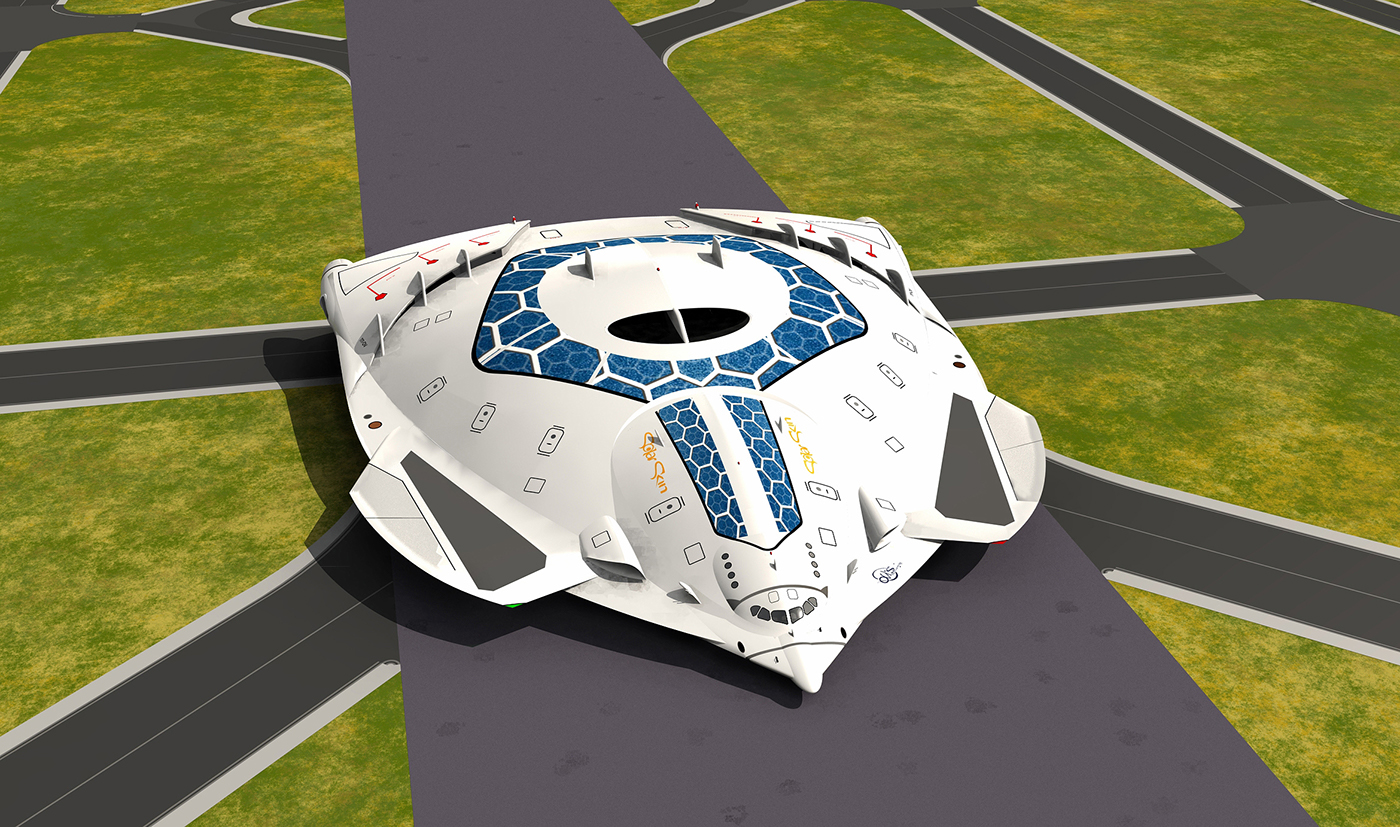

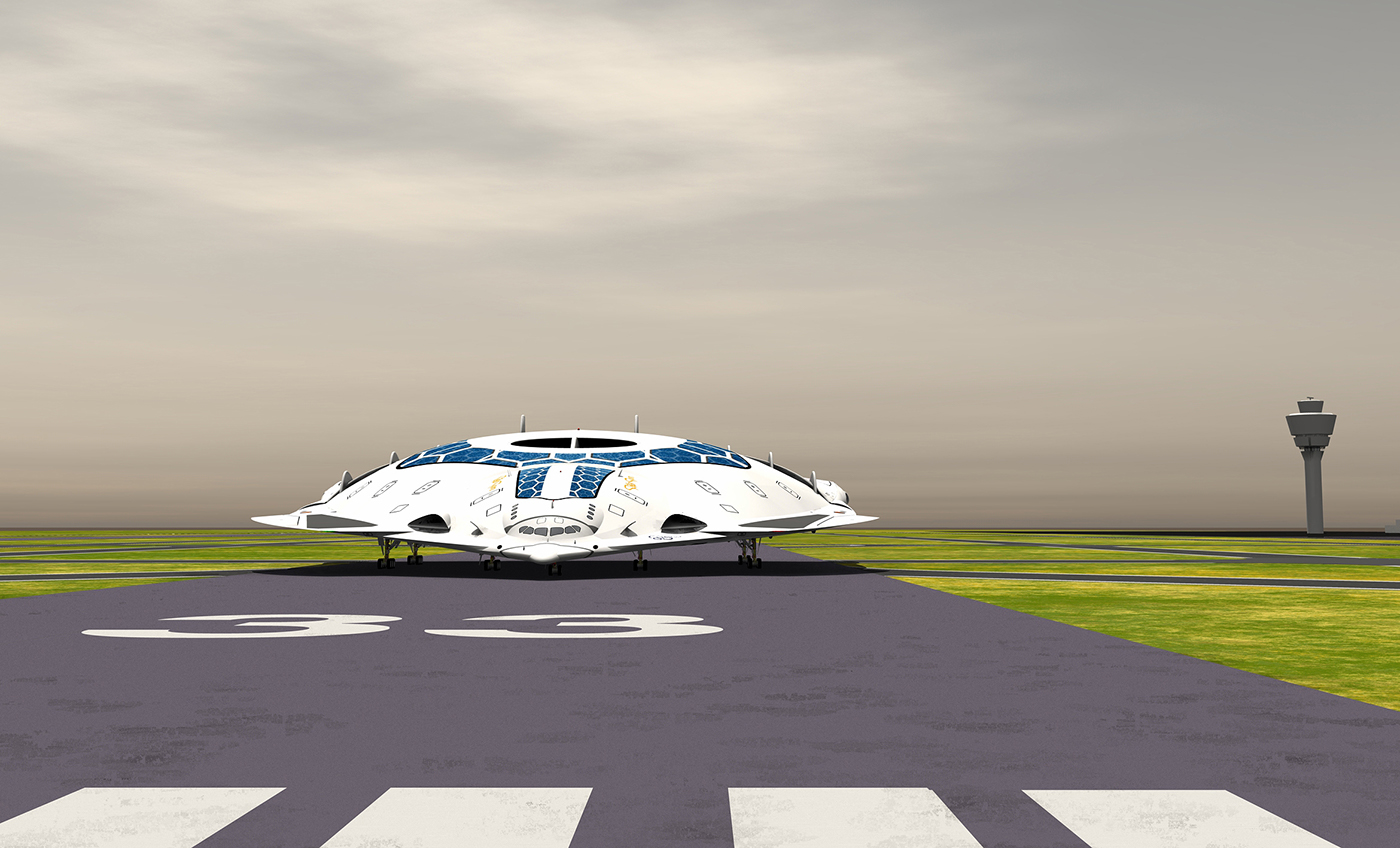


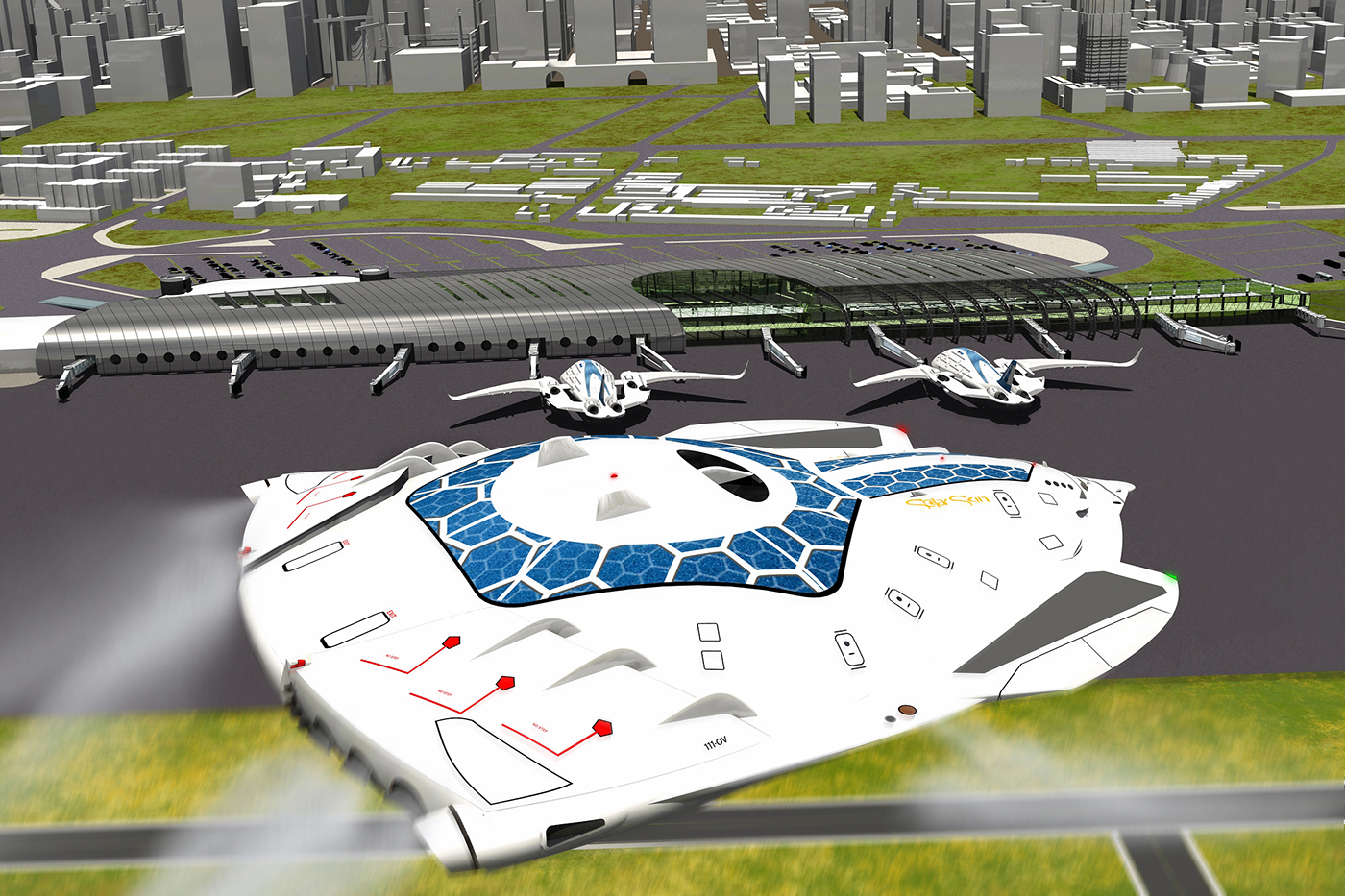
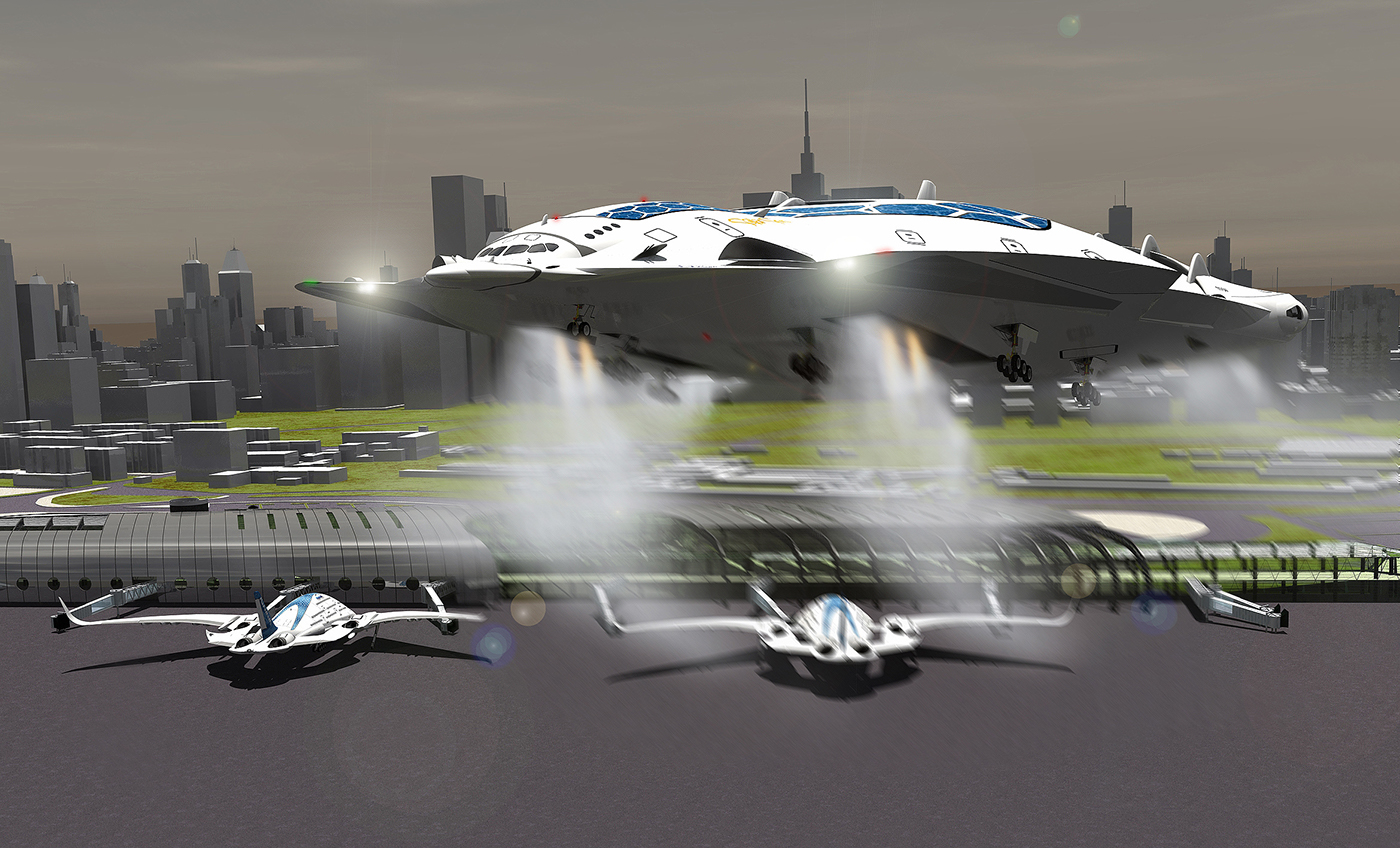


Vancouver International Airport Aerial photography by Alejandro Erickson


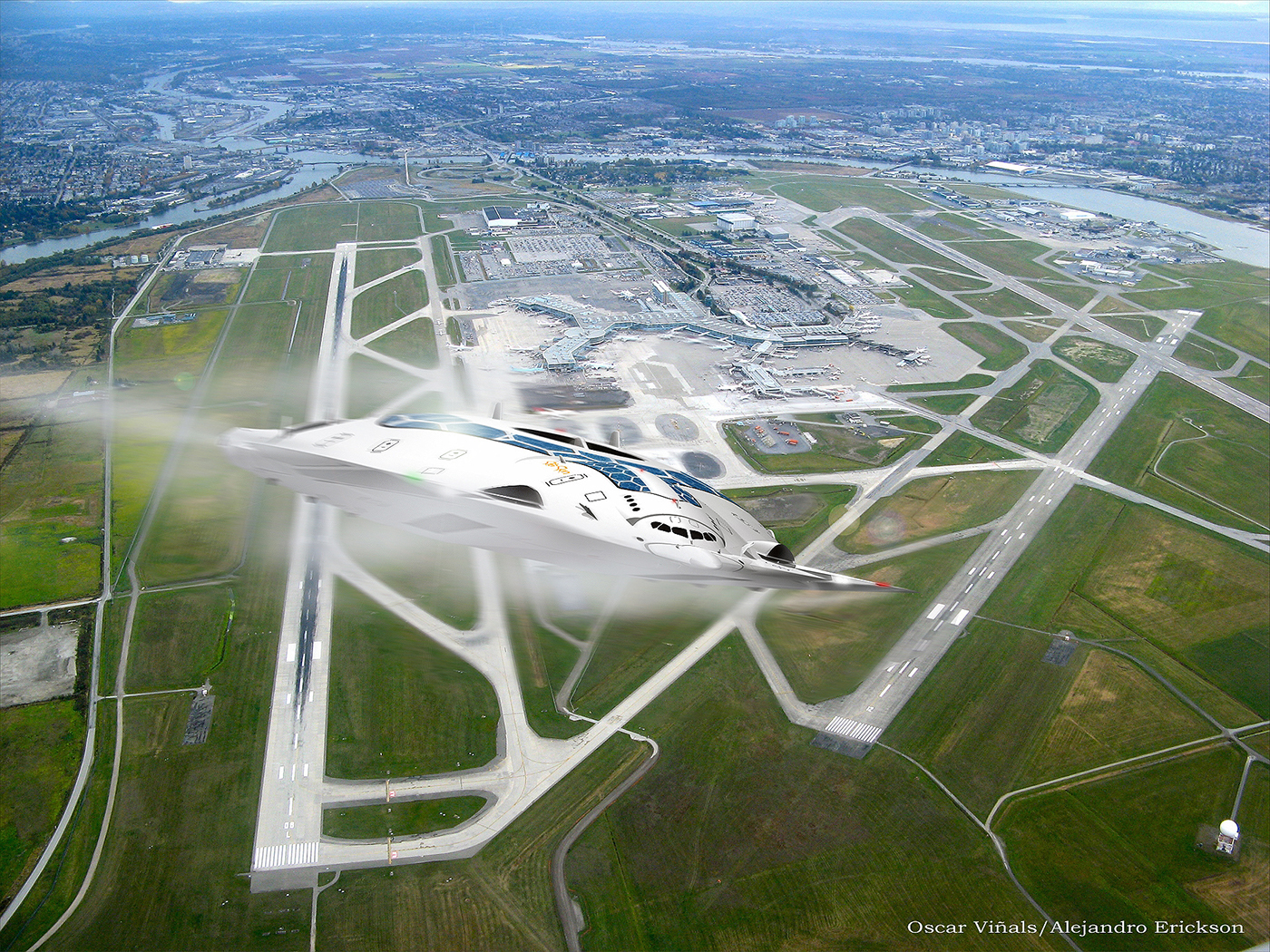
The design of the HSP "Solar Skin” is based on the “fusion” (mix) of the best technical and technological aspects about concepts like, the Blended Wing Body design or BWB, the new concepts of Airships like the “Airlander” and of course, some of my previous airplane designs, like the AWWA “Sky Whale” or the FF “Flash Falcon”. Also, I based this design in others fly mechanism like a “Wingsuit”, a Hang glider,…or on the other hand observing Nature “fly mechanism” like, the Flying Squirrels or Manta rays.
HSP is the definition of Hyper Shape Plane, it’s my form to describe this concept plane with its special & “personal” shapes.
The HSP "Solar Skin” looks a little “weird” or strange for today’s concept planes because it doesn’t have the usual wings… the airplane itself is a big smart wing with devices or “extensions” (front little wings, rear smart stabilizers and top stabilizers) making it all together, with its special shapes, a high performance plane. After, tested the design with CFD software and analyze in several fly conditions (lateral gusts, air turbulences, air vortex on the tips of the fuselage,…etc) , it may have a stable and very good balanced between its lift and drag coefficients. For example, it could improve the lift by around 35% at low speed (Takeoff) and decrease the aerodynamic drag at cruise speed.
Remembering the words of our honorable scientific & pedagogue, Carl Sagan when he described the Earth like… “a pale blue dot” in the infinite Cosmos and our necessity to protect the environment and this… “our Home”. So, we have to think in “a mind flip” about our future aircrafts. Electrical airplanes surely are to change the look of aviation, but if humans plan to continue to fly in the future we’ll have to embrace this new era of flight.
The most important challenge of the HSP "Solar Skin” would be, (apart of being an airplane with Zero emissions), to become a “big tool” to clean the atmosphere of CO2 and benefit us, providing Internet all around the World thanks to its Global Antenna System (thousand of these airplanes could act as a big solution for these challenges).
It would be an entirely Eco-friendly Airplane.
Other remarkable aspects of this plane would be its capacity to generate Energy for itself to fly and for another functions up to 80% ratio. So, it would be Super quiet (70% less than current Airplanes), thanks to its kind of engines and its nozzles, would be equipped with a system to absorb the engine’s noise.

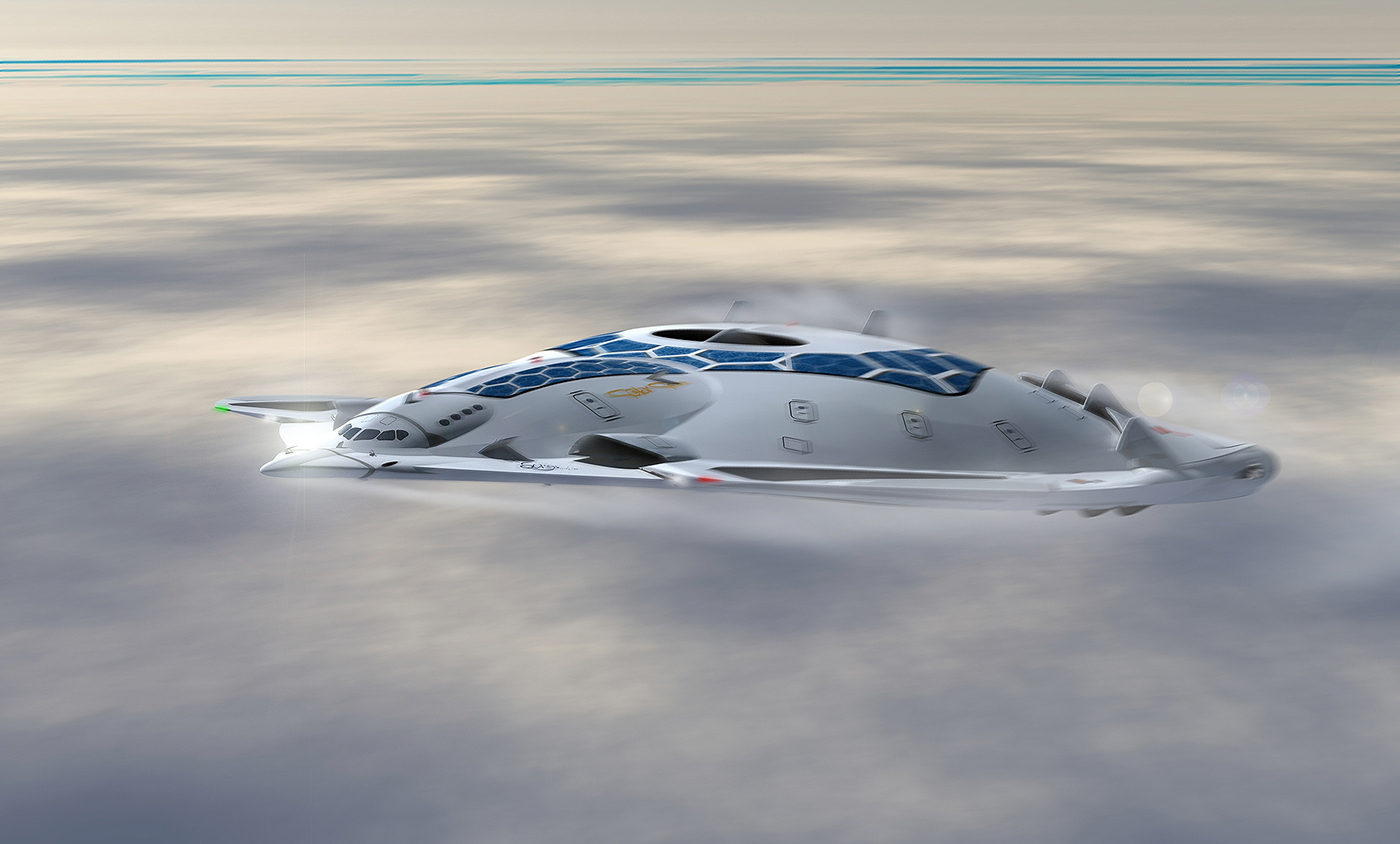

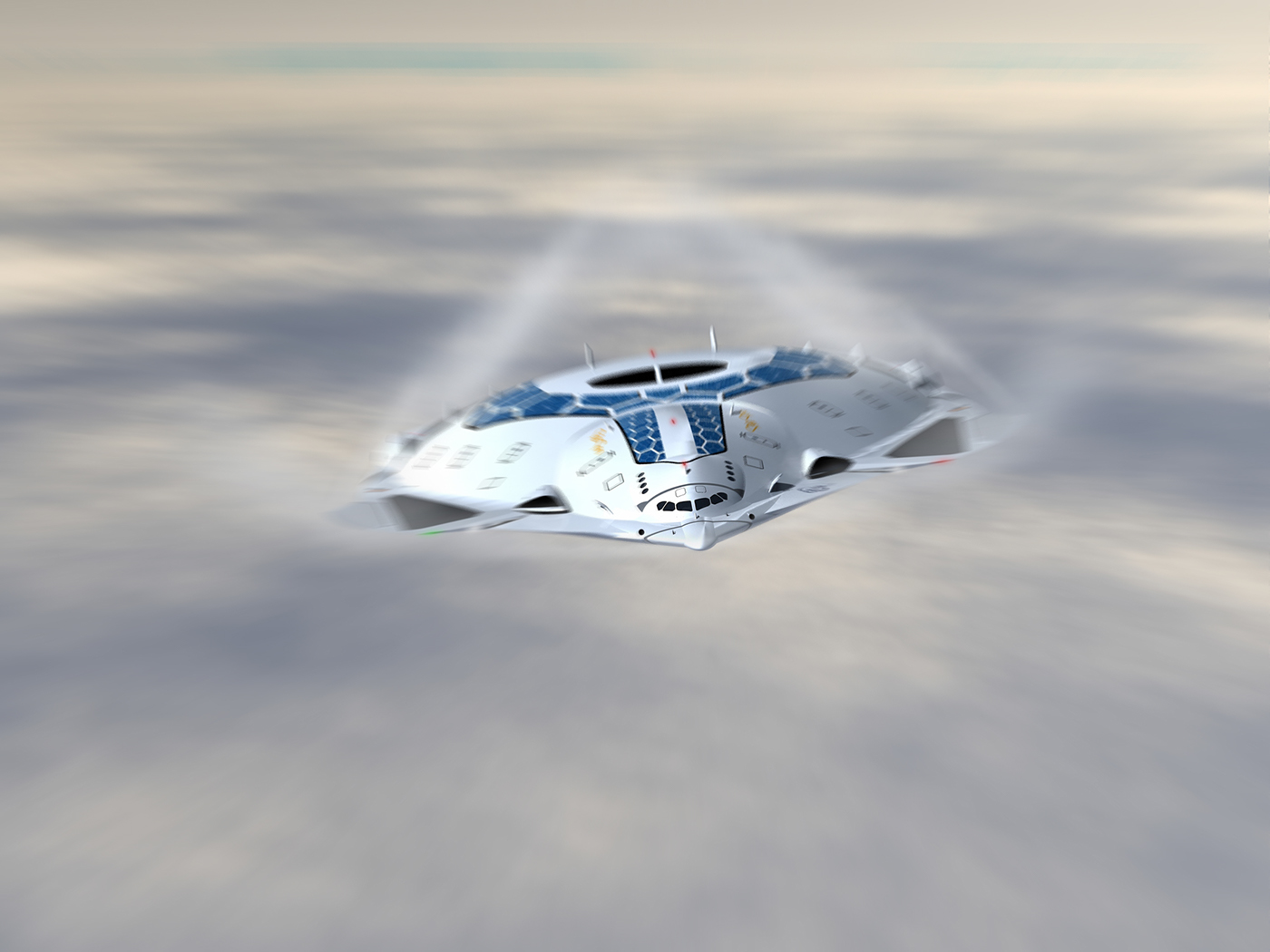
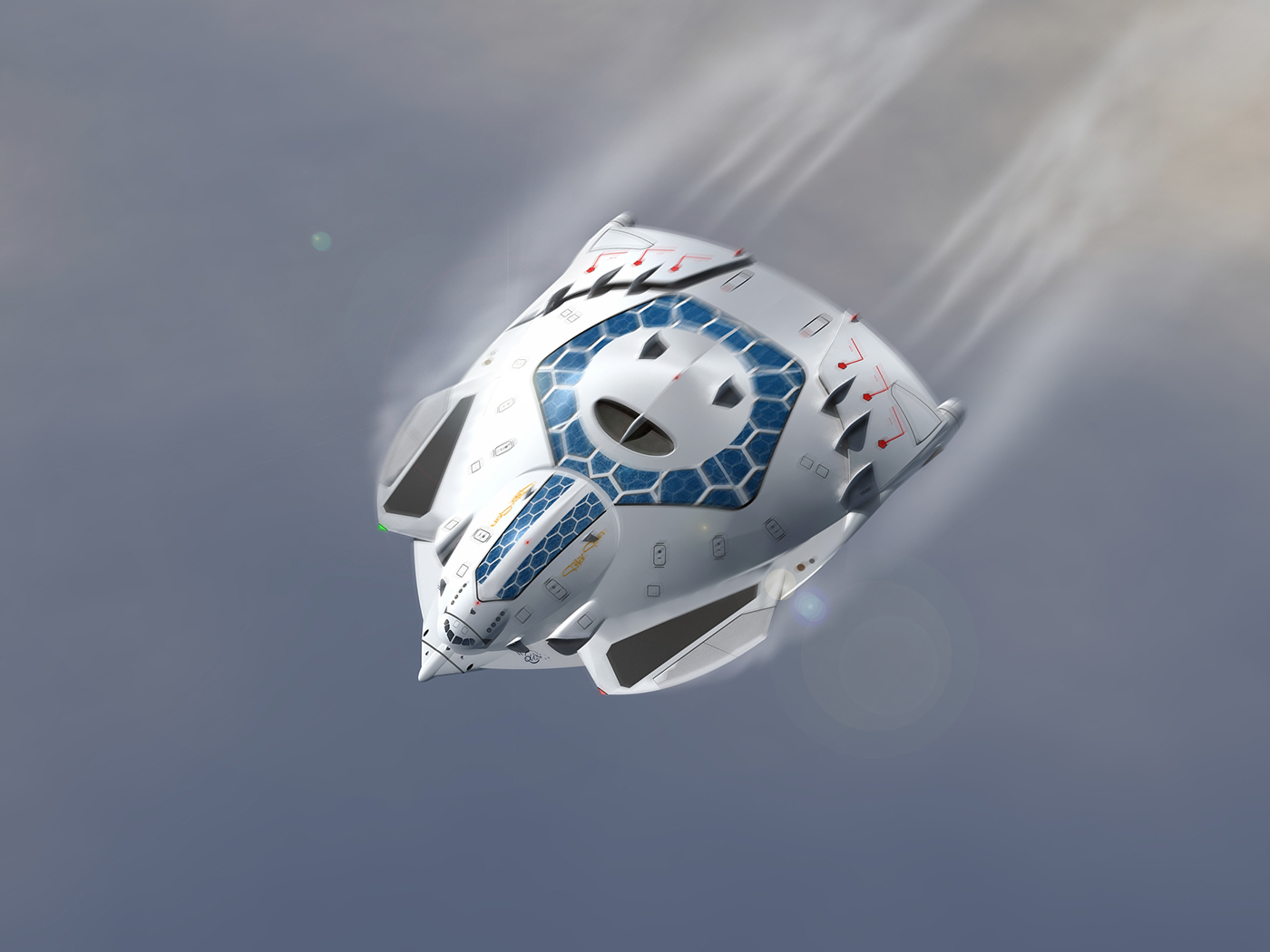




How is the HSP “Solar Skin”?
• Engines
The HSP “Solar Skin” would be equipped with 8 oversize Hybrid Engines (HEPJE), capable to produce a big amount of power thrust. A Superconducting Motor at High temperature as a principal engine, assisted by an Ultra High-Bypass section, that will “feed” 3 independent Plasma Chambers producing a “rocket push” in order to obtain a powerful thrust. The Plasma Chamber will mix little amounts of Hydrogen Fuel via airplane’s tanks with “air” via Ultra High-Bypass, both components will be burned at very high temperature (Plasma) and expelled with a thrust like a “rocket”. The HEPJE Engine would have 3 electromagnetic rings and a subchassis made of a combination of ceramic, gold & titanium materials in order to keep in the core (Superconducting Motor) a stable temperature of function & isolate it from the high temperature of the Plasma Chambers.
On the maneuvers of Take-off & Landing, the front engine’s thrusts are redirected to down side of the plane in order to create a “Harrier Jump jet” that reduces significantly the track distance to do those operations. The HSP “Solar Skin” could be equipped with a system based of two Rocket Engines (Hydrogen fuel -LH2-) in both sides of the plane, together with the Hybrid Engines, could redirect all the “front thrust”, in order to create a vertical “high thrust” to reduce to only approximately two hundred meters the distance to Take-off & Landing.
The HSP “Solar Skin” would be equipped with a “Thrust vectoring system” located on the rear nozzles and under the plane. Part of those nozzles (top side) could move 45 degrees, redirecting the engine exhaust to down side of the plane and creating a high pressure inside Engine’s duct. Together with this vectoring system, the rear nozzle would have a special duct on the bottom side that could redirect part of the engine exhaust at 90 degrees under the plane, in order to create a “Harrier jump jet”, it would be possible because the duct would act as a escape valve when the pressure exhaust would go up.
6 Duct Systems under the Airplane’ fuselage have the function to act like a V/STOL (Harrier Jump Jet ) system.
• Fly Controls
The HSP “Solar Skin” supplies the rudder device (change yaw, side to side) by two adjustable airflow ducts, that redirect the pass of it in order to change the yaw. These ducts are part of the same CO2 harvest system.
The Wind Generator duct is also used to control the vortex flows generated on the rear part of the Airplane’ fuselage. This would have a “special angle”/diffuser (top side) to redirect the forward air flow at high speed.
In the maneuver of approach to the airport, the HSP “Solar Skin” would fly in a “Gliding flight” with the engines in a “stand-by mode” and the wind generators working at 100%, generating big amounts of electric Energy and controlling the descent. The airplane could have a Glide Ratio (E) of approximately 17.3 (calculated by CFD software).
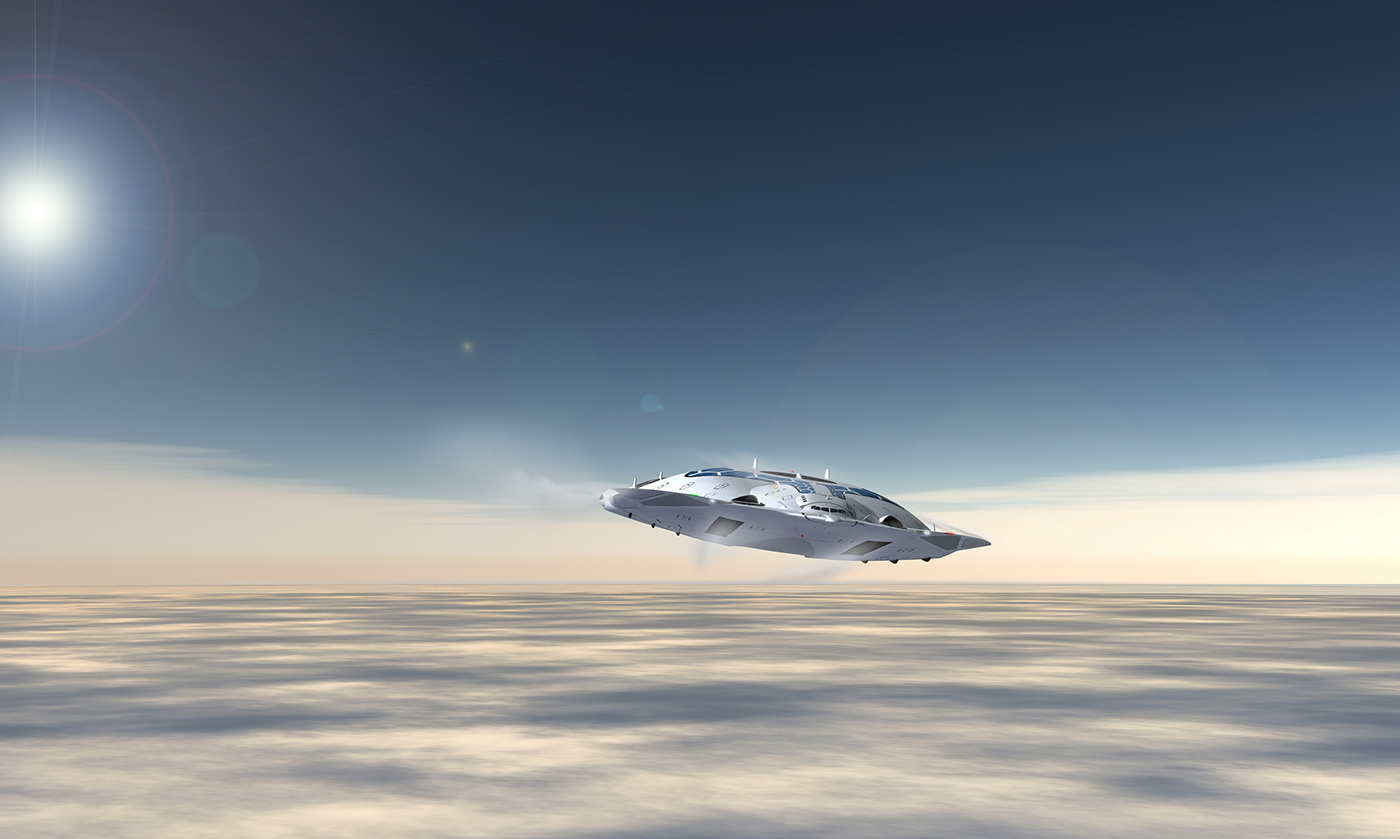







150th Anniversary of Canada
Congratulations!

Future Airliners?

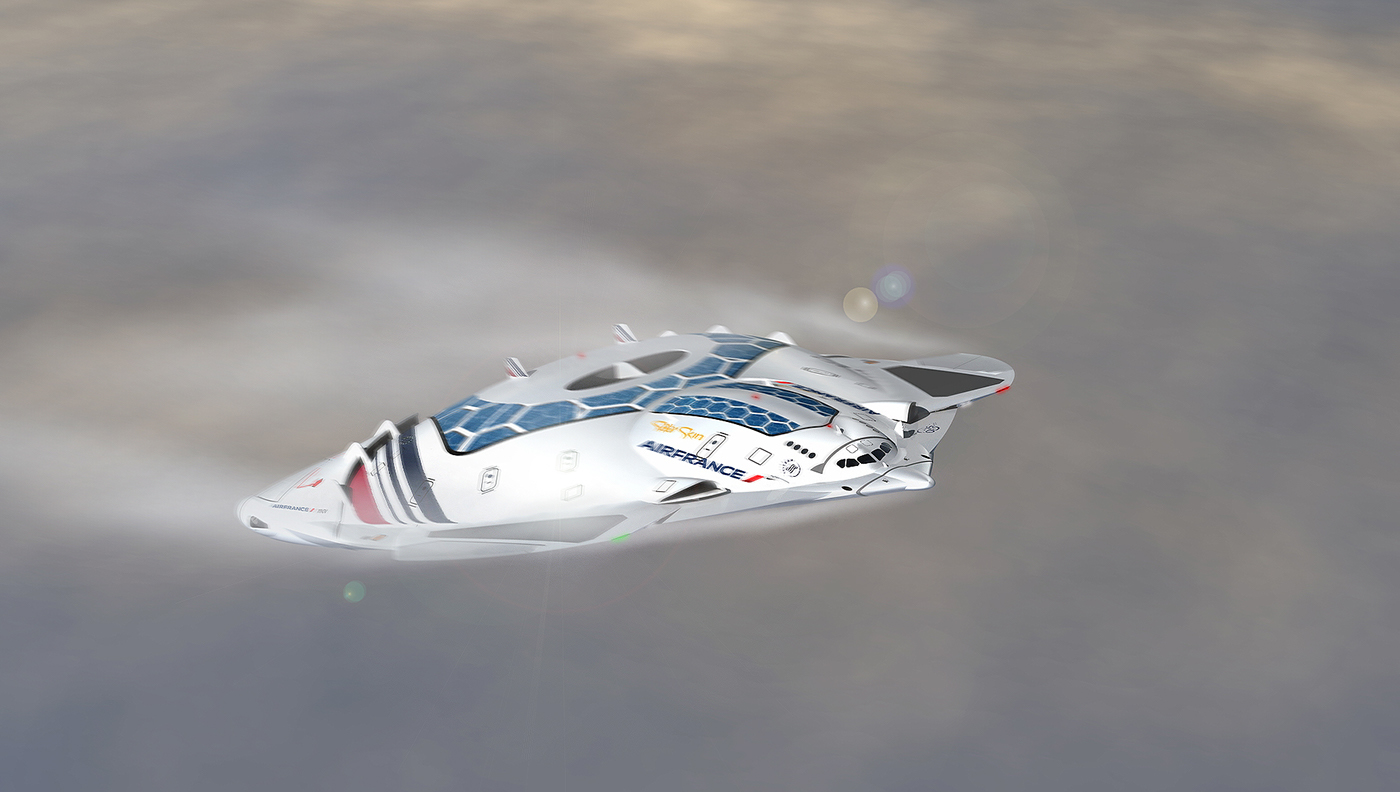
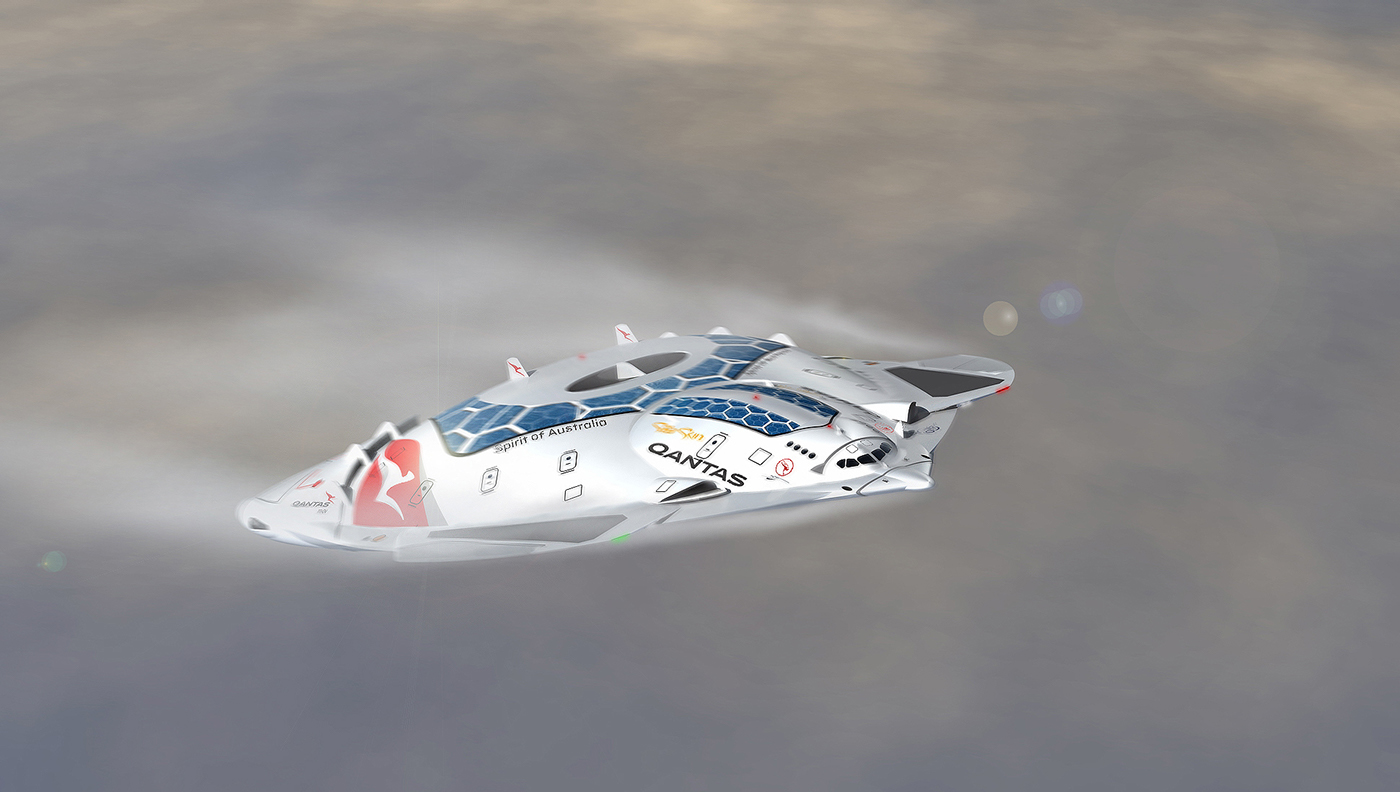
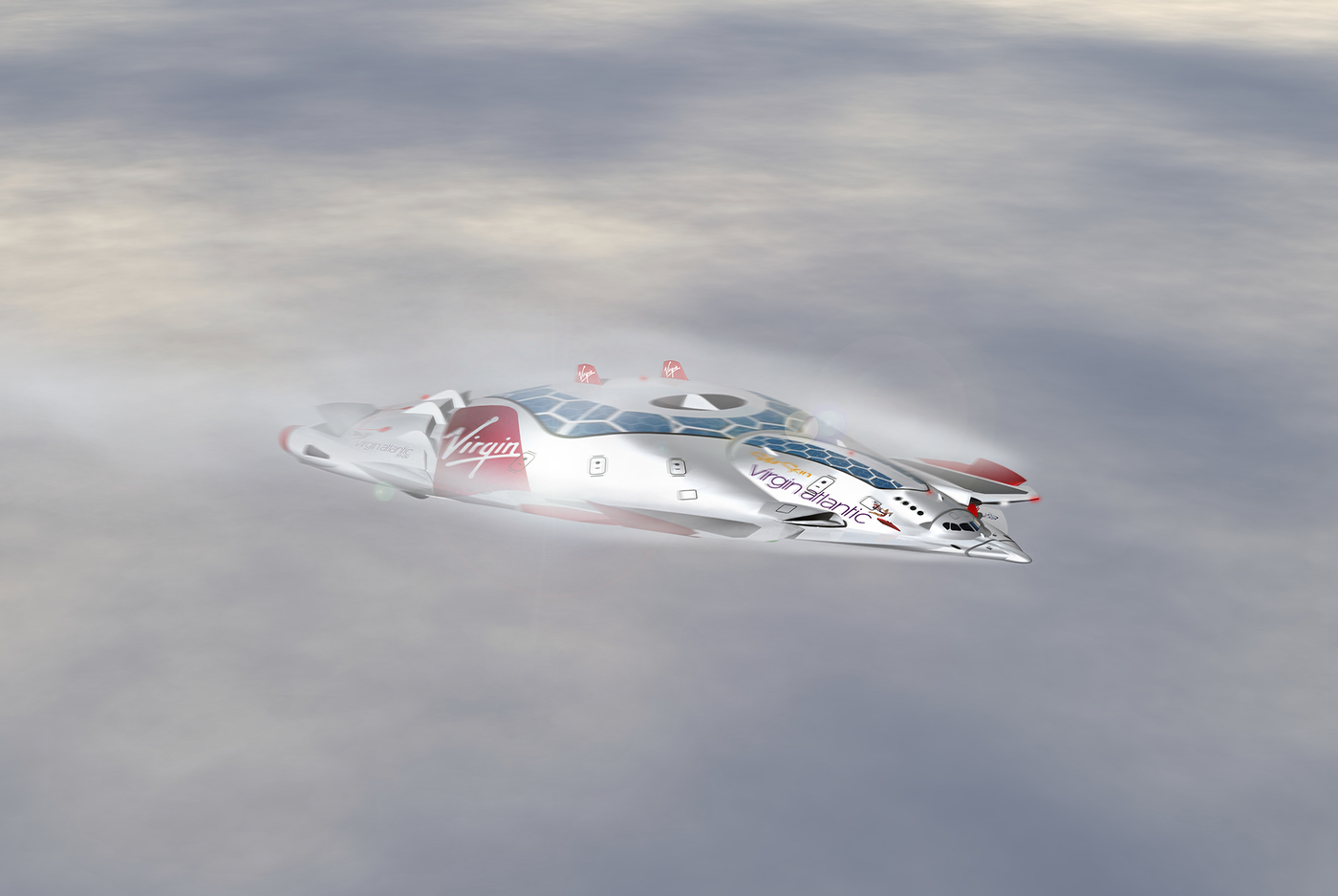


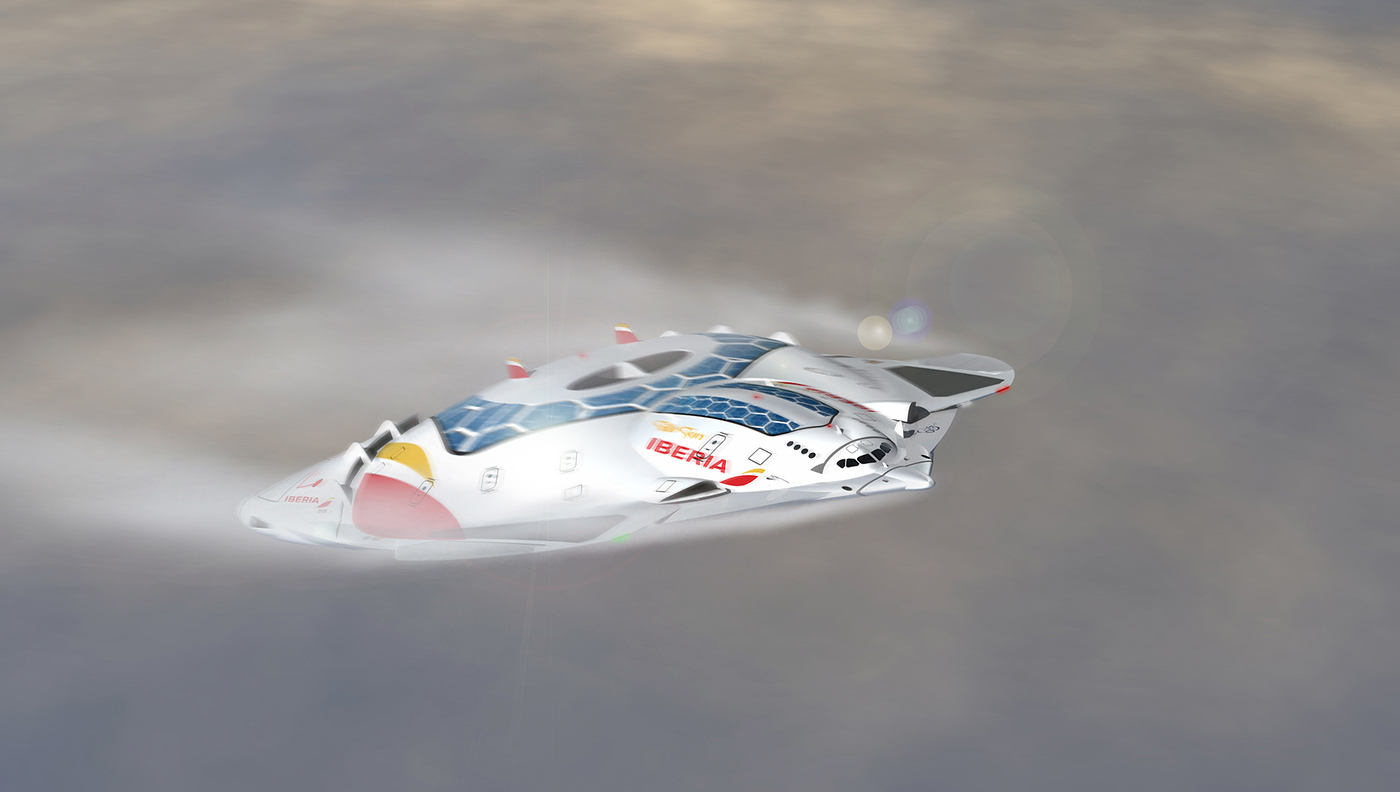

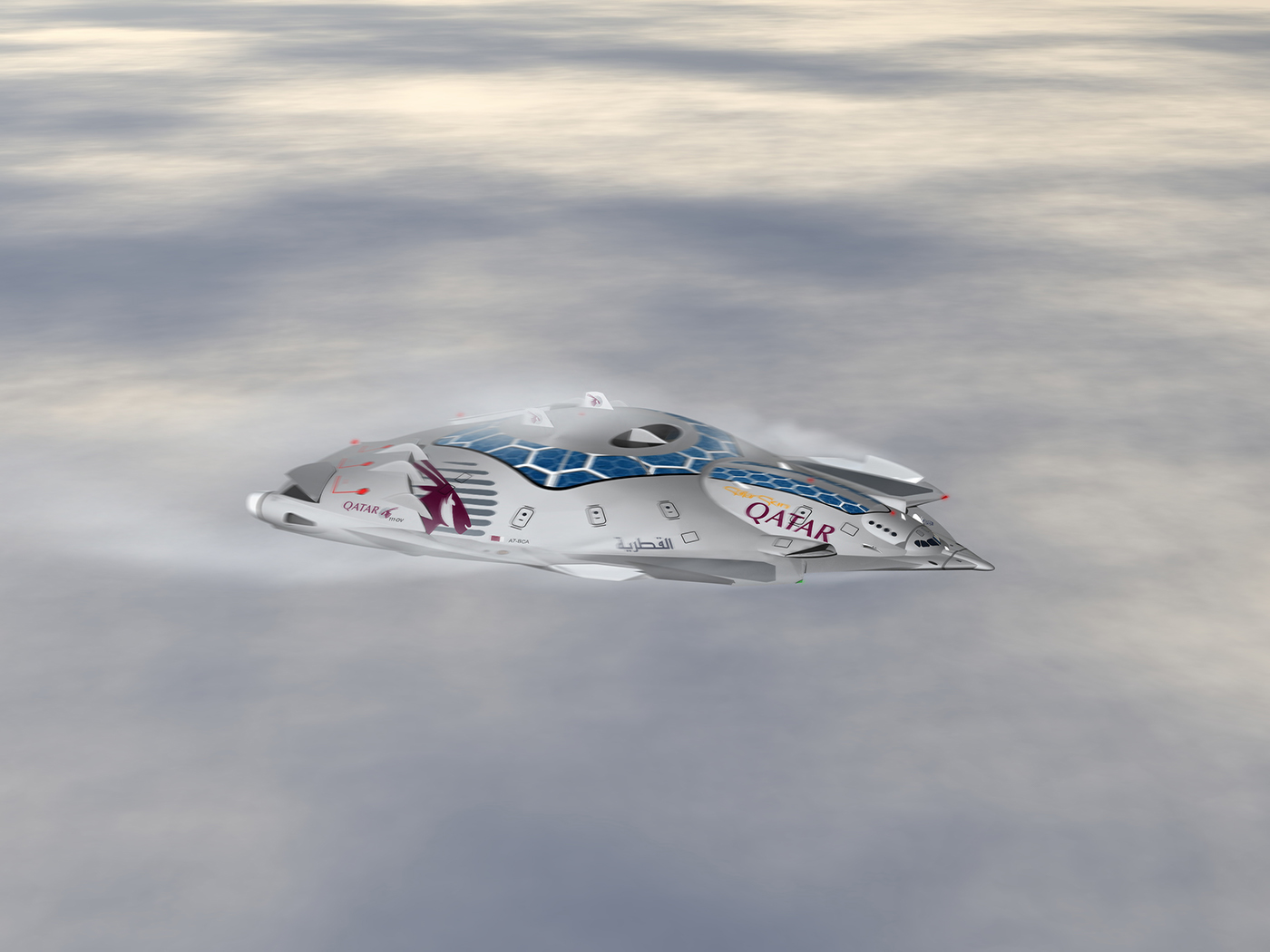

A Sci·fi concept, an entirely Eco-friendly Presidential Airplane... the future Air Force One?

• Multitask Airplane
CO2 Cleaner System This system could harvest directly from the air CO2, thanks to two air ducts covered with a synthetic membrane, coated with a special resin that could capture CO2 by attraction -The membrane consists of an "ion-exchange" resin – positive anions in the resin attract carbon dioxide, with a maximum load of one carbon-dioxide molecule for every positive charge. The airplane would be equipped by two CO2 storage tanks with a capacity of 10 tons (liquid). At the end of every fly the plane empty those, in order to recycle and use again the CO2 or to be “eliminated”.
Global Internet Antenna System “GIAS” The same system that the HSP “Solar Skin” could use to capture the Radio Waves, Microwaves, Earth’s Electromagnetic fields,...etc, could also act like an antenna between the satellites in orbit and any place of the World; providing global internet access with a big ratio signal/speed.
Energy Systems (Renewable Energy Resources):
• 2 Double Helix, Wind Turbines to generate electricity.
• 6 Powerful Thermoelectric Generators to generate electricity directly from HEPJE Engines ‘s heat, based on “Seebeck effect”.
• Glass with Quantum Solar dots (870m2 approx.) to generate electricity.
• Special Surface composed of a painted film with Quantum Solar Dots ( 1,140m2 approx. , Hundred Billion) to generate electricity.
• 160 Organic Semiconductors Panels (different types), that could harvest electricity from the radio wave, microwaves, Earth’s electromagnetic fields & include in a near future the “energetic Cosmic Rays”. Converting their magnetic spin current into electrical current. (part of this concept is based on studies from University of Utah physicists Valy Vardeny and Christoph Boehme)
• 2 big Hydrogen fuel cells located on the cargo bay together the Hydrogen’s tanks.
• 8 internal fuselage structures made of Carbon-fibre & Kevlar could hold the Electric Storage System of the plane. The structures could hold in a sandwich pattern an internal structure capable to storage & manage the Electric power produced by the Airplane. These would be resistant to “big forces”, stress, high/low temperatures, pressure changes and at the same time, lightweight. Also, would be part of the “crash system” of the plane, that could absorb in the fatal case of an accident, the inertial & crash forces in order to keep saved the core structure of the airplane (passenger compartment).
Structures based in layers of Graphene/Nanowires that could act like a Supercapacitors & powerful Batteries , with the capacities to be strong, thin & “flexible”. A system much more efficient and eco-friendly energy-storage solutions at lower price with a long cycle lifetime.Thanks to their low equivalent series resistance (ESR), supercapacitors provide high power density and high load currents to achieve almost instant charge in seconds. Temperature performance is also strong, delivering energy in temperatures as low as –40°C.

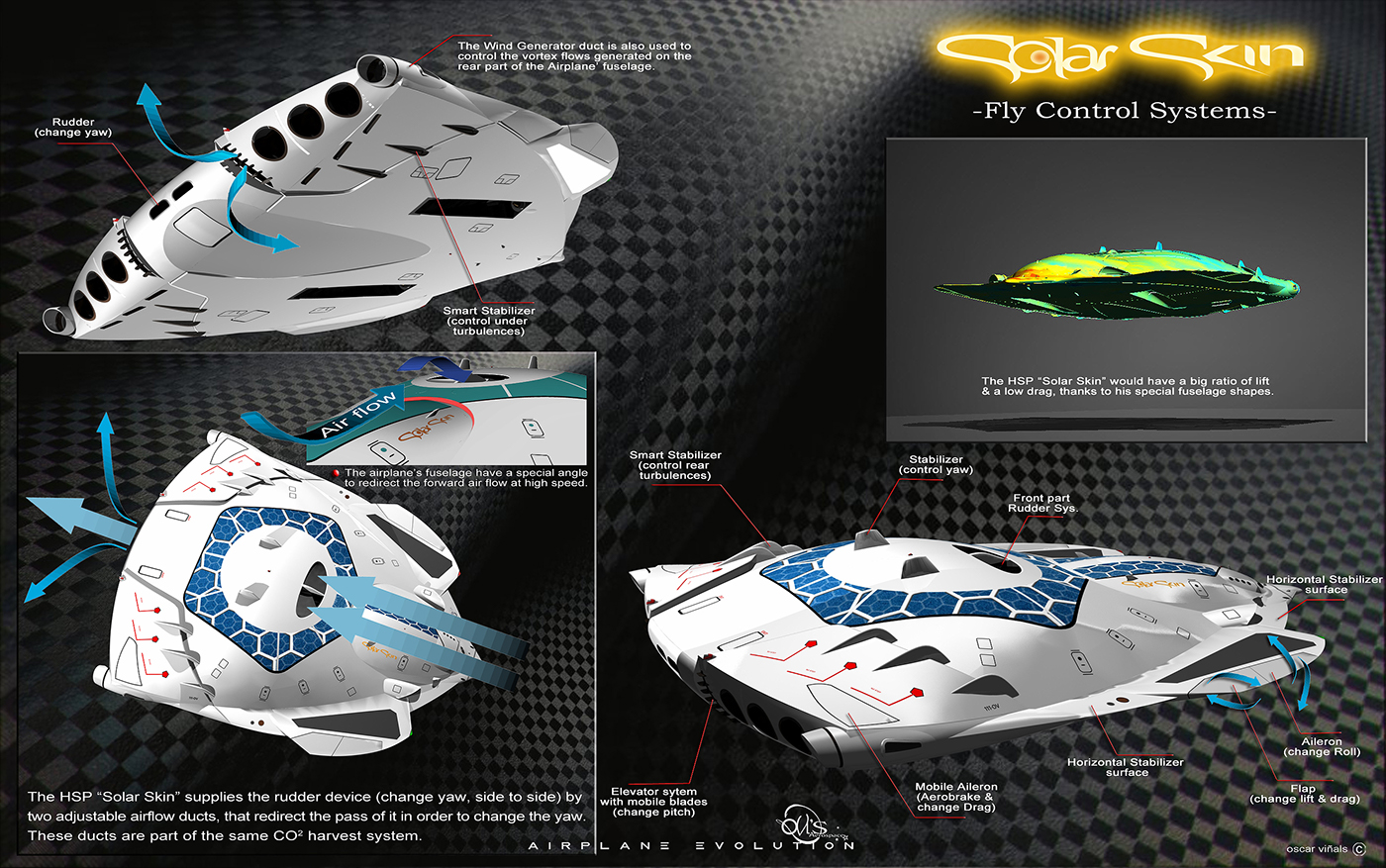

Sci-fi concept

Sci-fi concept
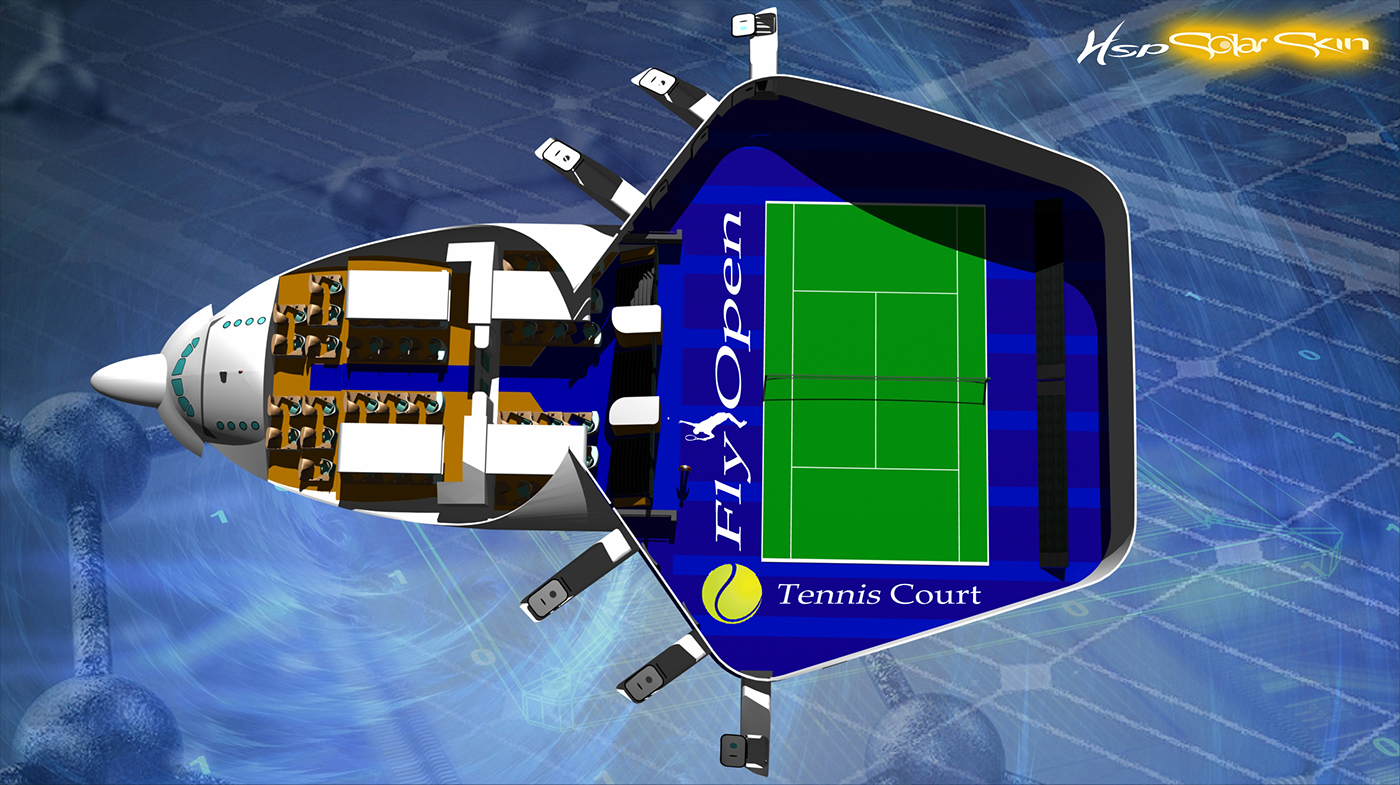


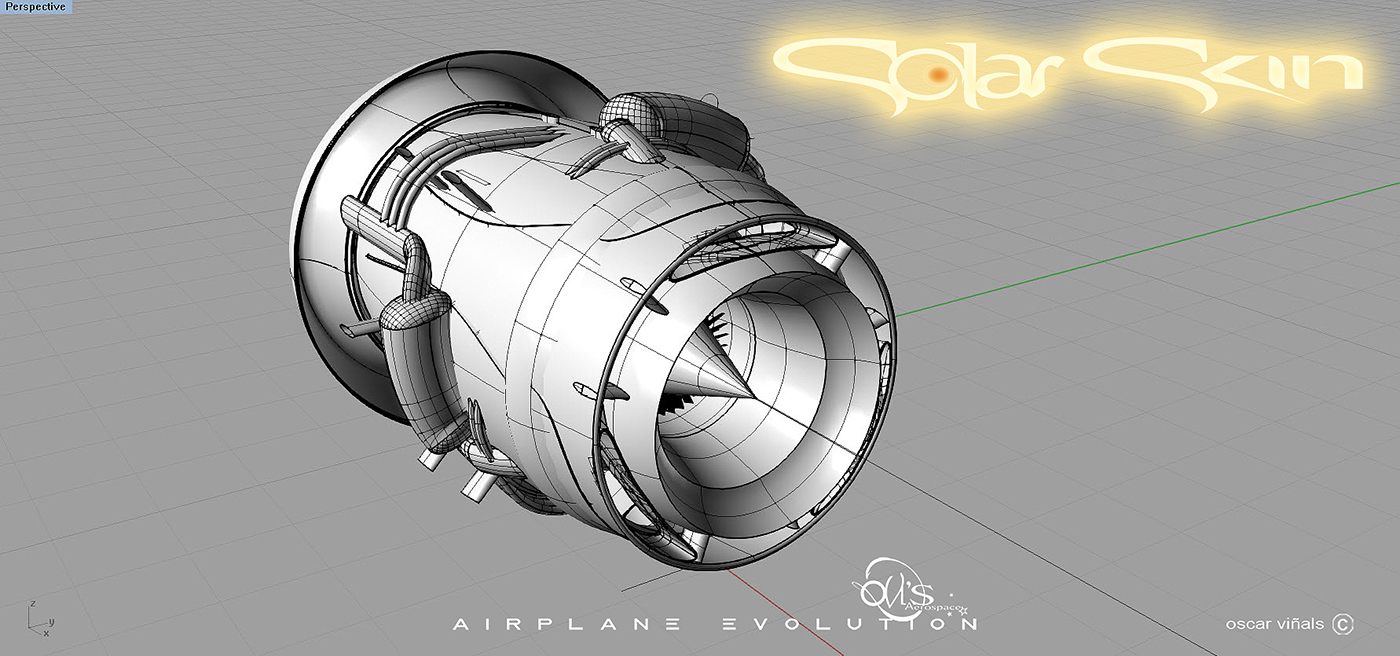


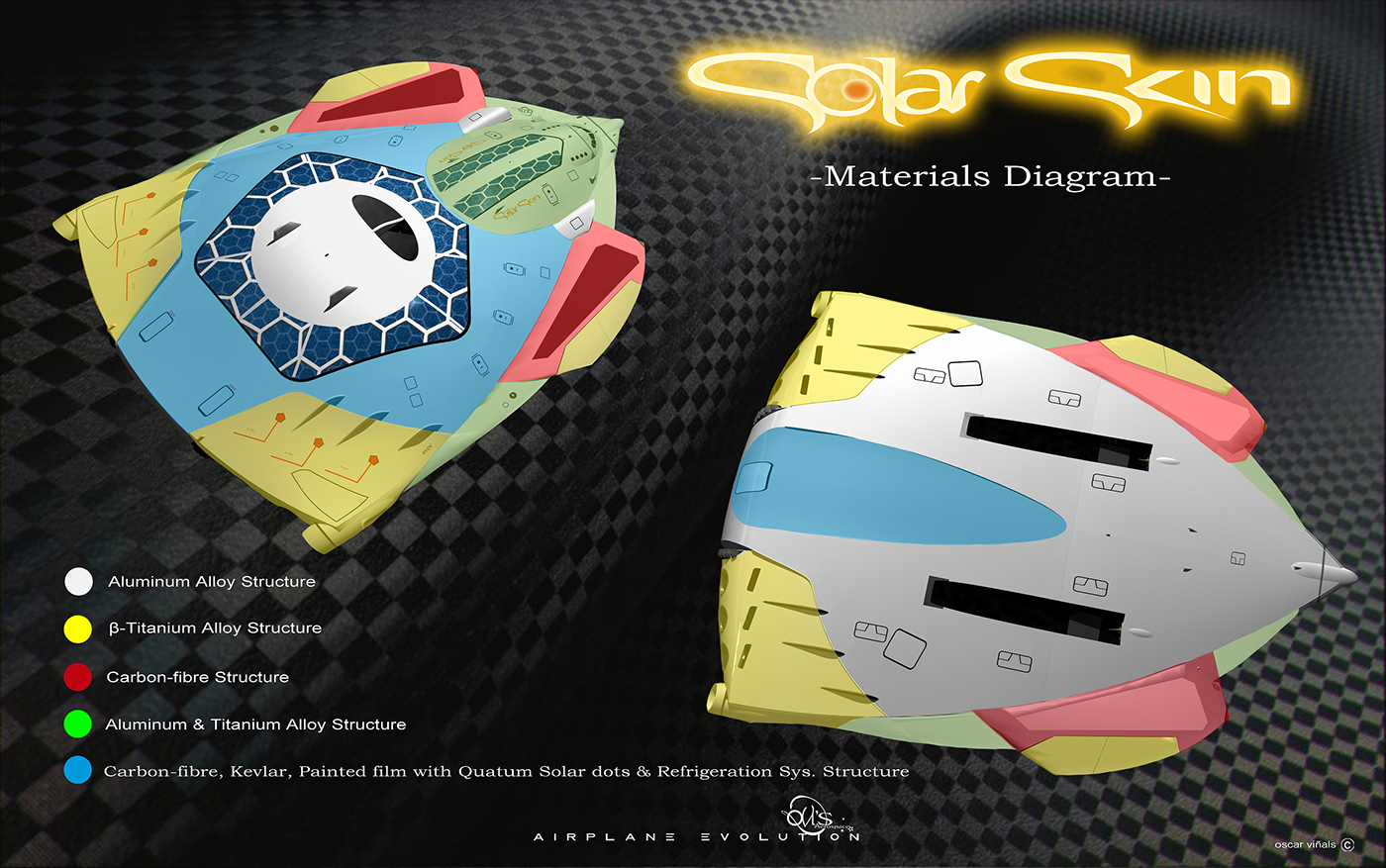


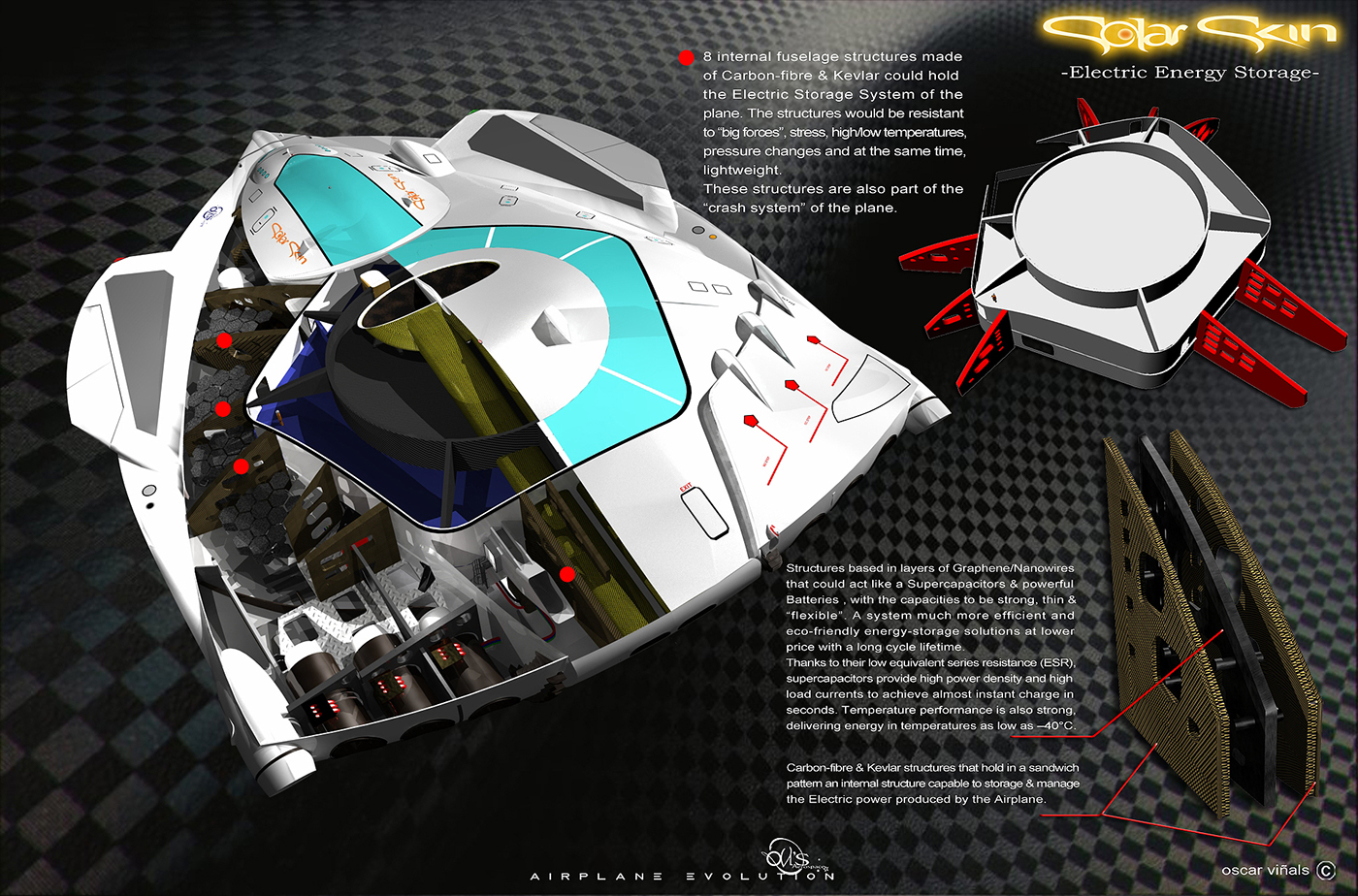
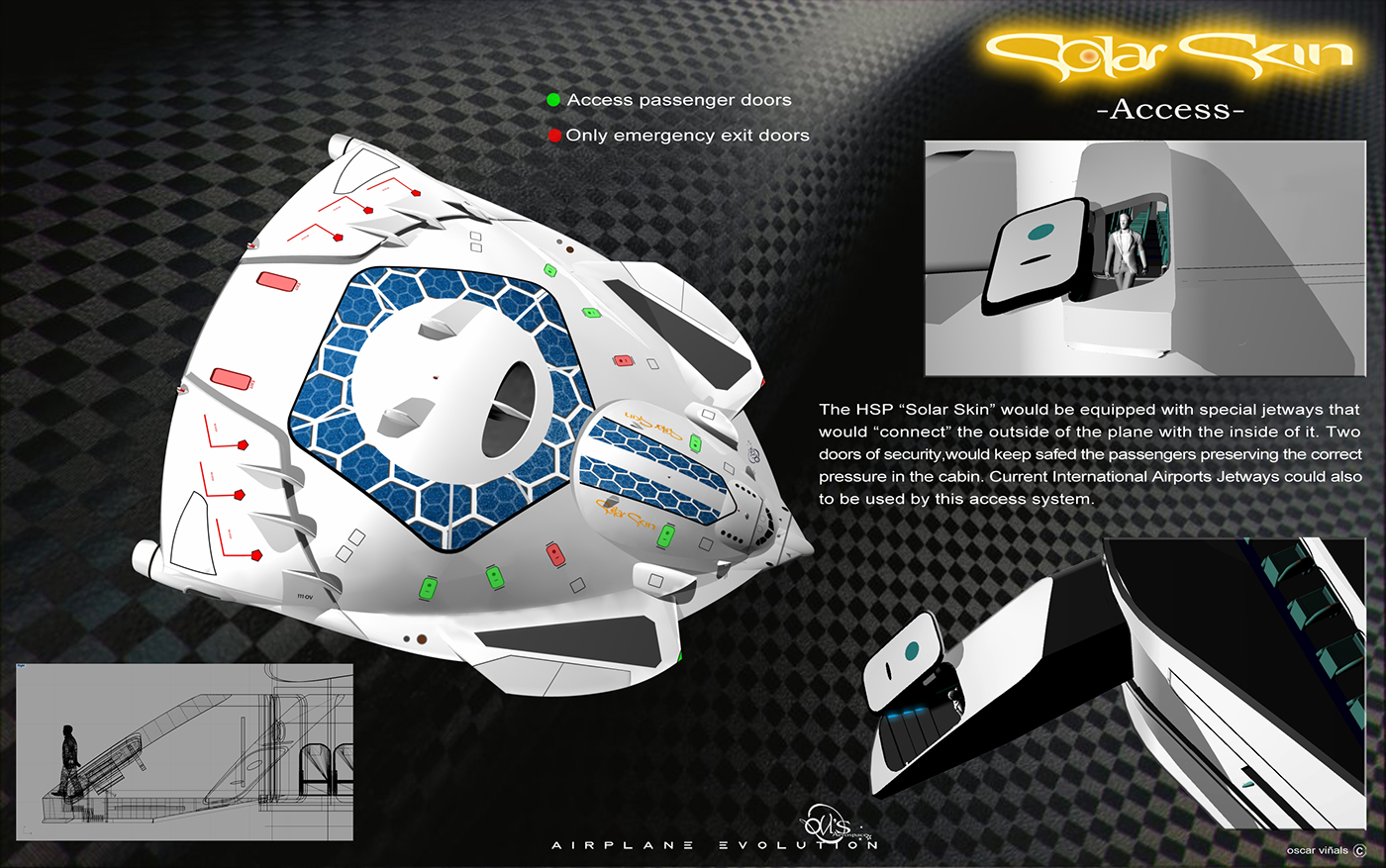

• Passenger Compartment
The passenger compartment would have a “modular system” capable to transform the usable area (1,153.2m2). It could have a capacity for 552 to 700 passengers or convert it into a Fly Hospital, a Luxury Hotel, a Casino, a Private Mansion, a Fly Tennis court...all that you could imagine in order to use the 1,153.2m2. Built with the best materials of this 21st century: Carbon fibre, Meta-materials, Titanium, Special Aluminum alloys, Nano-materials (Graphene), that provide qualities the like of Ultra Ligthweight, high strength, extreme temperature resistance, and more...The cockpit would have space for 4 crew members (2 pilots & 2 engineers) with a private living room.
Super Tourist Class (440 to 560 seats)
Business Class (98 to 120 seats) First Class (12 to 22 seats)
The Super Tourist Class seats would have a pitch of 45’’ and a Width of 20’’. Virtual reality on the walls of the passenger compartment and directly views of the Sky on the ceiling.
The airplane would have an amazing Cargo bay with the capacity to transport “big payloads” like cars (10) or other similar objects. With an Area of 851.2m2 and a Volume of 2,128m3, the possibility to transport all kind of payloads is very large. On the cargo bay there would be located the Hydrogen’ tanks and the Fuel Cells, in order to obtain the best distribution of airplane’s masses.
The HSP “Solar Skin” would be equipped with special jetways that would “connect” the outside of the plane with the inside of it. Two doors of security, that would keep saved the passengers preserving the correct pressure in the cabin. Current International Airports Jetways could also to be used by this access system.
Designed by Oscar Viñals
April, 27 · 2017










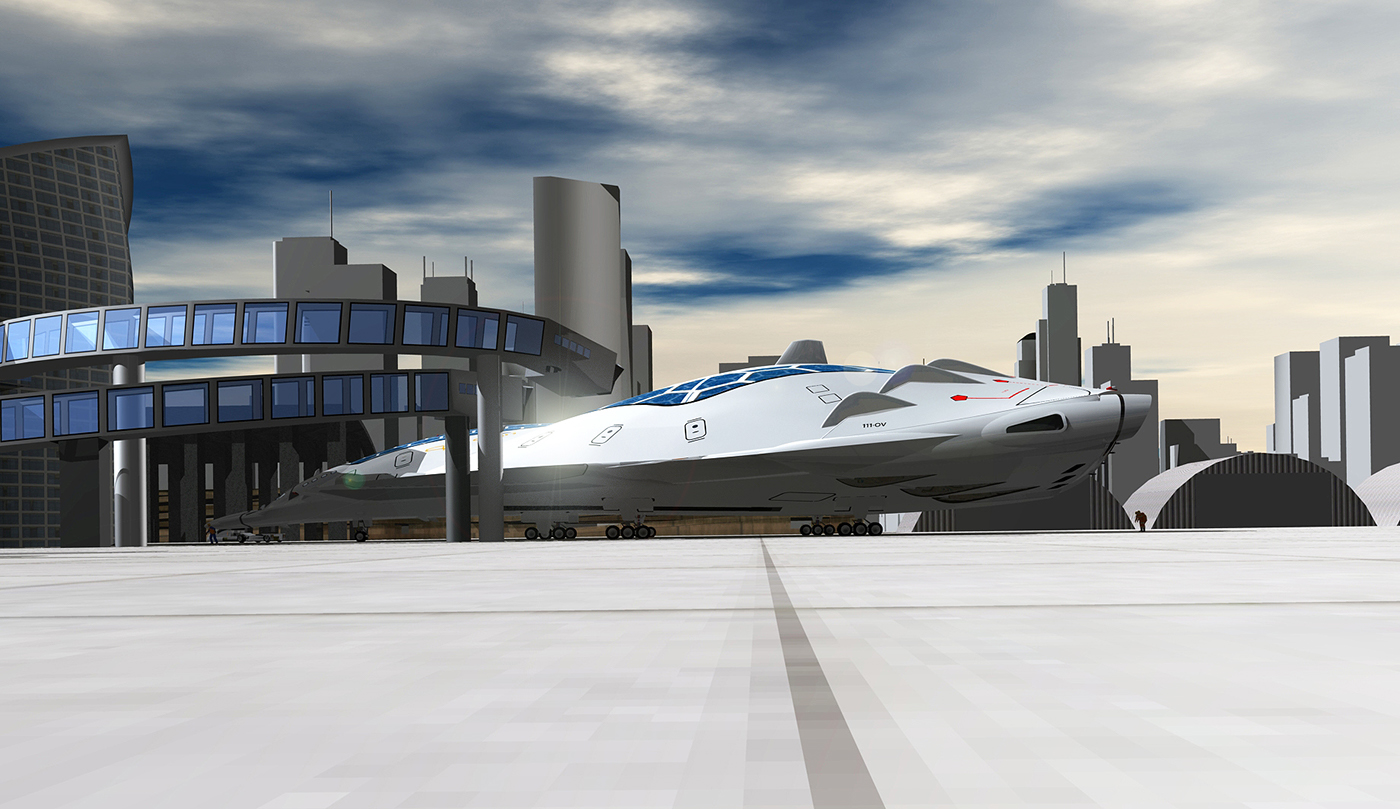





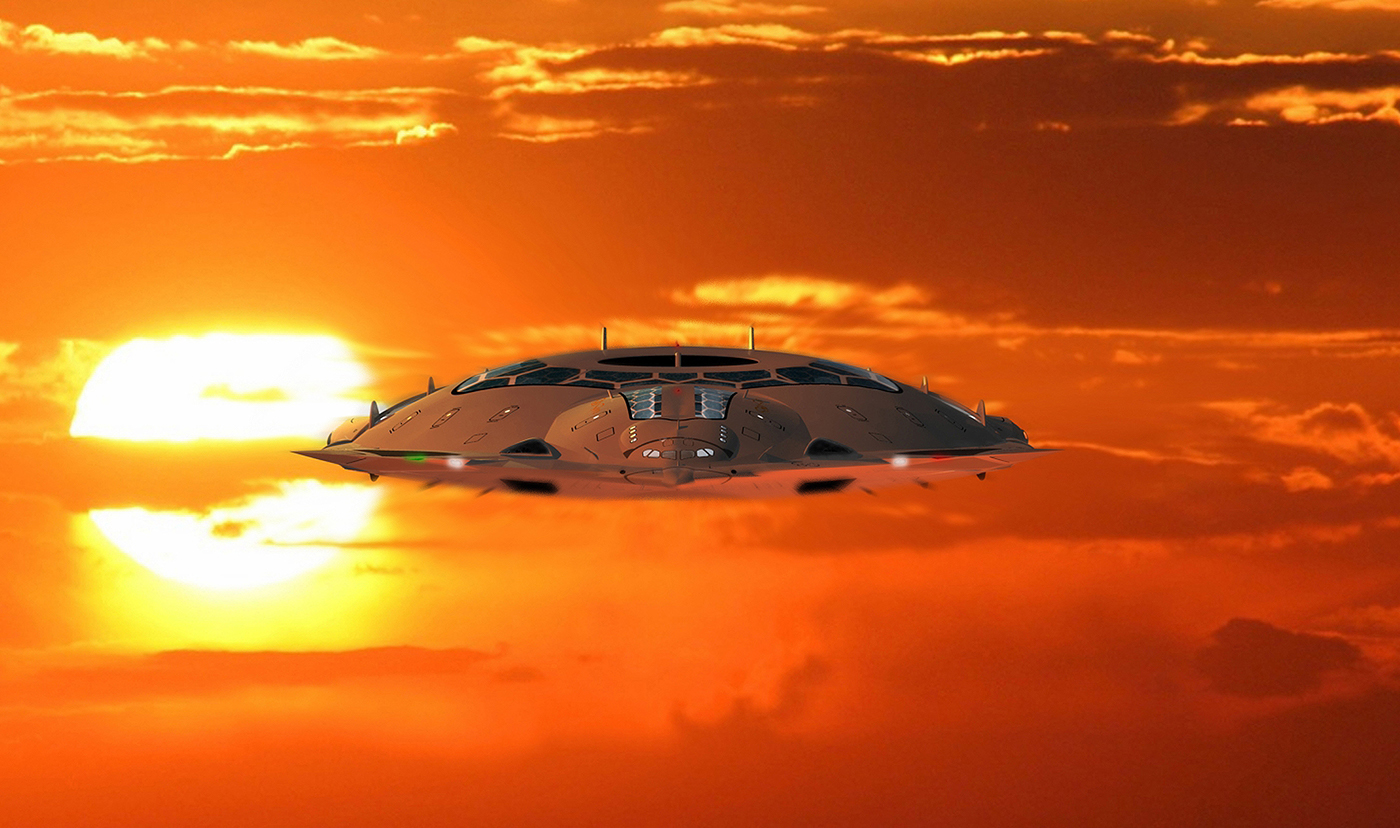


...see you soon with another interesting project, Thank you all for your attention.
